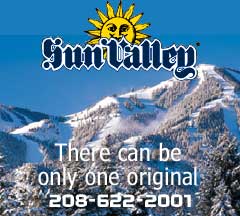|
Russia:
Moscow, St. Petersburg,
A Tale of Two Cities
by Nancy & Eric Anderson
Photography by Authors
 ussia
is not the easiest country to explore, even today. A tourist infrastructure
doesn't exist, signs are written in Russia's impossible Cyrillic alphabet,
and it's hard to find any street Russian who speaks English. ussia
is not the easiest country to explore, even today. A tourist infrastructure
doesn't exist, signs are written in Russia's impossible Cyrillic alphabet,
and it's hard to find any street Russian who speaks English.
Plus it's the largest country in the world. To travel its width by train
takes eight days and nights. Any tourist wishing to savor this country
would find its very size indigestible. Russia, the easy way, is to nibble
this huge country in small bites. A good beginning would be to stick
with European Russia, staying west of the Ural Mountains. And the best
appetizer would be to visit, first, the two most famous cities in the
country, the two who have collided so often during Russia's tempestuous
history: Moscow and St. Petersburg.
Those cities are less than 400 miles apart. It's an easy flight; in
fact, some flights to St. Petersburg from the West are routed via Moscow.
But given the unbelievably high cost of hotels in Moscow -- a city for
three years topping surveys of the World's Most Expensive Cities --
we discovered a better answer than flying between them: Go by river
boat up the expanded Volga-Baltic Waterway and not only enjoy the two
fabulous cities that book-end its waters but taste the very heart of
Russia as you languidly meander past its medieval towns.
Many river boat companies have discovered the tourist attraction of
the Volga, the longest river in Europe. We went with Viking River Cruises,
"the largest river cruise company in the world." In contrast
to many river cruise companies, it owns its own boats.
Viking River Cruises had us, the first day, barreling in a bus down
the main drag in Moscow, Leningradsky Prospekt. Natalie, our guide,
pointed out places of interest. "That's Cafe Pushkin, the most
expensive restaurant in Moscow and that one, there, is the least expensive."
She was pointing to McDonalds. "When it opened in 1986 Russians
lined up in queues for three hours. Over there," she said, "is
the Bolshevik Chocolate Factory and that's the wedding palace for marriages."
Our heads spun
There were statues everywhere of persons whose names are completely
unknown to Westerners. "And there," pointed out Natalie, "is
a palace with statues of lions that look like crocodiles because the
sculptor had never seen lions!"
We were on our way from our river boat port to a concert at the Gallery
Tretyakov, next door to the famous museum of the same name. It was a
captivating classical folklore performance introduced by the conductor
who told his audience, "Tonight we will be playing music from Russian
history, Russian culture and maybe even Russian soul."
We discovered Russia's soul many times on this trip that took us into
the very being of a country that could have been at one time our enemy
in battle. When we watched the changing of the guard at the Tomb of
the Unknown Soldier it reminded us all nations have their sorrows because
of war.
We found a nation that had suffered for a century yet still could laugh.
"That building over there is our parliament where so many representatives
labor to make our life harder," said Natalie.
We toured museums, mostly ones we've never heard of.
And we saw churches. Boy! Did we see churches.
We recall once being on a tour through France and, as we struggled up
a steep slope at the end of a long day, a fellow tourist grumbled to
his wife, "ABC!"
"What does that mean?" we asked.
"Another bloody cathedral," he replied.
We had a lot of ABCs on this cruise yet they were undoubtedly one of
the best parts of the trip.
Later we were shown the intricacies and the architectural triumphs of
the Moscow Metro. Moscow's underground rail system is surely something
the Soviet Union did right. The maps were helpful and enabled us to
travel around on the free time of our second day in the city. With the
group we visited Red Square, photographed St. Basil's Cathedral, checked
out the celebrated GUM department store and watched the changing of
the guard at the grave of the unknown soldier.
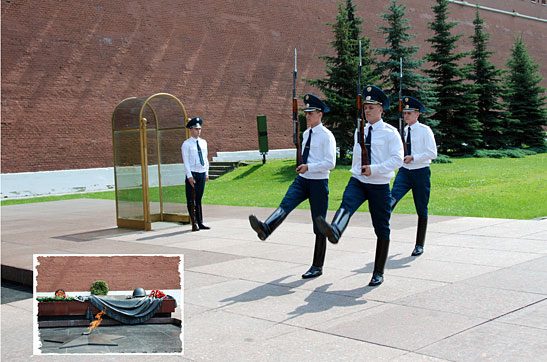
There were other Viking optional choices: out-of-town
trips to the New Maiden Nunnery; a tour to the former royal estate at
Kolmenskoye; or an excursion to the city once called Zagorskthe or;
easier for those on their own, a visit to the Museum of the Armed Forces
- or, a real temptation, to the State Tretyakov Gallery, Russia's largest
art museum, housing more than 100,000 Russian works, many nationalized
from private collections.
Next day, however, we explored Moscow ourselves and chose to go to the
Pushkin Museum of Fine Arts, a visit that proved to be one of the highlights
of our trip. We went looking for its 1898 display of impressionists
and European art understanding some paintings that were now on display
had been hidden for decades for ideological and political reasons. We
walked into rooms, one full of Van Goghs, one of Monets, another of
Renoirs, and yet others overflowing with Gauguin and Picasso. But it
was the individual paintings that overwhelmed us: such as a most moving
scene of a wedding staged before a rural family called Nuptial Benediction
1880-81 by Pascal Adolphe Jean Dagnan-Bouveret; and After School 1844
by Ferdinand Georg Waldmuller.
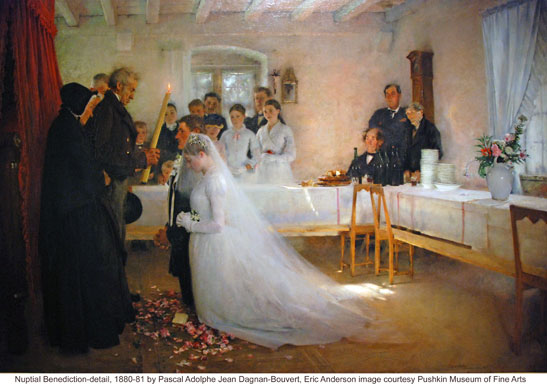
The memory of this art persisted as we passed St. Basil's
Cathedral next day even as we toured the Kremlin in our included Viking-guided
tour, studying first the ten Imperial Faberge Easter Eggs in the Armory
-- of the 54 to 57 made only 44 are still known to exist. We looked
at the huge boots worn by Peter the Great made by the monarch himself,
we surveyed the solid throne of Ivan the Terrible and we gaped at the
Coronation dress with the 17 inch waist made for Catherine the Great
- one of the 15,000 dresses made for her because she never wore a dress
more than once. We staggered through the Armory, our guide pointing
to bejeweled crowns, some with a thousand diamonds, and gilded Cinderella-like
carriages, and rooms almost suffocating with religious icons. We saw
ornamental clocks taller than a man and elaborate Czar horse tackle
that included silver horse shoes and nails. We saw porcelain and crystal
and amber and ivory and gold plates and silver goblets … and by
the time we left the armory we, at least, understood why the peasants
and students began a revolution in October of 1917.
In contrast the Czar's great cannon cast in 1586 and weighing 40 tons
seemed downright sensible, just what every army needed. The most colorful
church we entered in the Kremlin, the Cathedral of the Assumption was
almost overwhelming. It had the Monomakh Throne the royal seat of Ivan
the Terrible 1533-84; and the Tabernacle that included the remains of
one Patriarch Hemogen who apparently starved to death in 1612 during
the Polish invasion. This cathedral displayed those multi-paneled iconostasis
walls that dominate all Russian churches, though this wall dated from
1652.
Our boat seems to sense it was now downhill to St. Petersburg -- literally.
In fact we passed through 18 locks and dropped nearly 600 feet on our
meandering 1100 mile cruise from Moscow. The "Blue Route"
along the Svir river and through Lake Ladoga brought our boat late at
night into this famous city that Peter the Great created, in a mere
seven years as if he were God, to be his "window on his western
world."
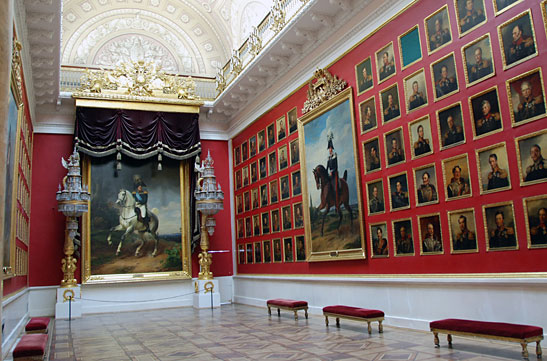
Our greatest anticipation was for the world-famous series
of art museums, the Hermitage, the "gluttony of art" fashioned
by Catherine the Great for her Winter Palace. She began in extraordinary
fashion: 800 canvases snapped up in an initial order across Europe followed
by 400 more, then 600, all in 10 days. She had the funds and the impoverished
rulers of Western Europe had the art. Her accumulations continued throughout
her lifetime, collections from ancient Egypt to early 20th Century Europe
-- more than 3 million items to show the world: 1,000 rooms, 12,000
statues, 18,000 paintings and one million coins, for example. Therein
lies the problem; no one can do justice to this visual feast. Not only
is there too much displayed, some of it with less than ideal presentation,
but the very popularity of the sprawling museum creates such crowds
it can be as much fun as flying today. We suffered, too, because only
37 of the most celebrated 57 showrooms were opened to the public. We
were told that much of the famous art was on international tour to bring
in badly-needed funds to restore the five museums that constitute the
Hermitage.
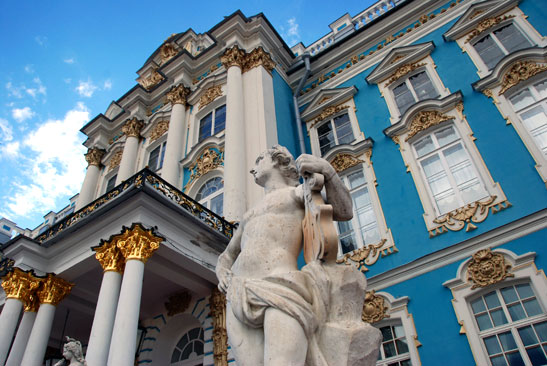
There were crowds, too, at the village of Pushkin, a
few miles out of town that has Catherine's Palace, her glorious summer
estate, the main attraction being her Versailles-like home with its
600 foot-long façade -- again stuffed with possessions of the
period. Badly damaged in World War II it has been magnificently rebuilt.
Like the Hermitage it considers the question: Is more better? with the
answer, Yes. And the thought: When is enough, enough? with the response,
Never!
Viking River Cruises offered, as in Moscow, optional tours here to both
Peter the Great's Peterhof Palace and to the "aristocratic mansion"
once owned by the wealthy Yusupov family until 1917, but to us the real
charm of St. Petersburg lay not in the magnificent places that stand
beyond its borders but in its streets and along the canals that gave
the city its name "the Venice of the North." We used a public
bus to get from the river port to a Metro station then it was a quick
trip into Nevskiy Prospekt, the main thoroughfare.
We walked all over St. Pete during Navy Day when patriotic Russians
had taken to the streets and would embrace anyone even tourists. They
willingly posed for photographs and gave directions in sign language.
But with a good walking map it was easy to find the famous Church-On-Spilled-Blood,
completed in 1907 on the spot where Czar Alexander II was assassinated
in 1881. The church was reopened after extensive restoration in 1997.
Although its Eastern Russian Revival style is unusual in a city that
Peter the Great built to embrace the West and its architecture, the
magnificent church with its incredible75,000 square feet of mosaics
might well be the highlight of any visit to St. Petersburg.
If You Go
Visas are required for Russia so allow adequate time
for that. We came to Russia with invaluable guide books: DK Eyewitness
Travel Moscow that cost us $23 and, an even better buy at $12, DK Eyewitness
Travel Top 10 St. Petersburg. Both had superb maps but we found a company
online, Russian National Group, that has an office in New York City
and great walking maps of Russian cities: info@rnto.org
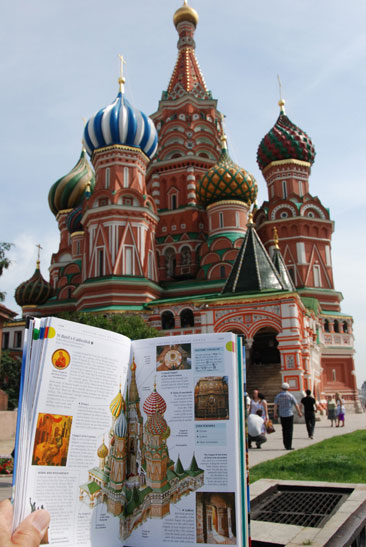 In
both cities, the closest Metro station was an easy walk or bus ride
and the busy metro itself (once we got a Viking guide to print the Cyrillic
name of our downtown Metro stop) was actually easier for us to negotiate
than our own listless San Diego trolley system! Viking included in both
Moscow and St. Petersburg a full day and a half of guided tours with
admission to the major attractions and evening performances of a classical
folklore concert in Moscow and a ballet performance (Swan Lake) in St.
Petersburg. We had a free time day in each city where Viking offered
optional tours at prices from 37 to 59 Euros each which included, for
each museum, transportation from the boat dock, admission and a group
guide. These tours were very popular with most of the passengers who
argued the increased cost was minor compared to total costs and the
convenience, but we feel travel writers have to explore on their own
to understand and enjoy a country. Also one of us is Scottish and, er,
frugal. In Moscow we did the Pushkin Museum for a total of about $2
for our Metro tickets and 600 rubles ($26) for our Pushkin admissions. In
both cities, the closest Metro station was an easy walk or bus ride
and the busy metro itself (once we got a Viking guide to print the Cyrillic
name of our downtown Metro stop) was actually easier for us to negotiate
than our own listless San Diego trolley system! Viking included in both
Moscow and St. Petersburg a full day and a half of guided tours with
admission to the major attractions and evening performances of a classical
folklore concert in Moscow and a ballet performance (Swan Lake) in St.
Petersburg. We had a free time day in each city where Viking offered
optional tours at prices from 37 to 59 Euros each which included, for
each museum, transportation from the boat dock, admission and a group
guide. These tours were very popular with most of the passengers who
argued the increased cost was minor compared to total costs and the
convenience, but we feel travel writers have to explore on their own
to understand and enjoy a country. Also one of us is Scottish and, er,
frugal. In Moscow we did the Pushkin Museum for a total of about $2
for our Metro tickets and 600 rubles ($26) for our Pushkin admissions.
Russia by river is not inexpensive. Paying up front in US dollars for
the cruise may stabilize costs as the world continues to spurn the currency
we once thought special. But being charged on board for water, sodas
and wine in Units where one Unit equals one Euro sure hurts. Cabins
vary in price according to when you book and what you want. Air costs
are prohibitive. We snatched up air when prices dropped briefly but
even then we paid $3300 for two in bottom-line Economy. We flew Lufthansa
and used Viking River Cruises for air purchase as it included airport
transfers.
|




![]()



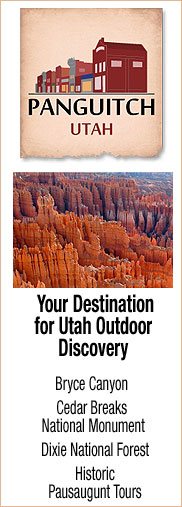













 In
both cities, the closest Metro station was an easy walk or bus ride
and the busy metro itself (once we got a Viking guide to print the Cyrillic
name of our downtown Metro stop) was actually easier for us to negotiate
than our own listless San Diego trolley system! Viking included in both
Moscow and St. Petersburg a full day and a half of guided tours with
admission to the major attractions and evening performances of a classical
folklore concert in Moscow and a ballet performance (Swan Lake) in St.
Petersburg. We had a free time day in each city where Viking offered
optional tours at prices from 37 to 59 Euros each which included, for
each museum, transportation from the boat dock, admission and a group
guide. These tours were very popular with most of the passengers who
argued the increased cost was minor compared to total costs and the
convenience, but we feel travel writers have to explore on their own
to understand and enjoy a country. Also one of us is Scottish and, er,
frugal. In Moscow we did the Pushkin Museum for a total of about $2
for our Metro tickets and 600 rubles ($26) for our Pushkin admissions.
In
both cities, the closest Metro station was an easy walk or bus ride
and the busy metro itself (once we got a Viking guide to print the Cyrillic
name of our downtown Metro stop) was actually easier for us to negotiate
than our own listless San Diego trolley system! Viking included in both
Moscow and St. Petersburg a full day and a half of guided tours with
admission to the major attractions and evening performances of a classical
folklore concert in Moscow and a ballet performance (Swan Lake) in St.
Petersburg. We had a free time day in each city where Viking offered
optional tours at prices from 37 to 59 Euros each which included, for
each museum, transportation from the boat dock, admission and a group
guide. These tours were very popular with most of the passengers who
argued the increased cost was minor compared to total costs and the
convenience, but we feel travel writers have to explore on their own
to understand and enjoy a country. Also one of us is Scottish and, er,
frugal. In Moscow we did the Pushkin Museum for a total of about $2
for our Metro tickets and 600 rubles ($26) for our Pushkin admissions.











